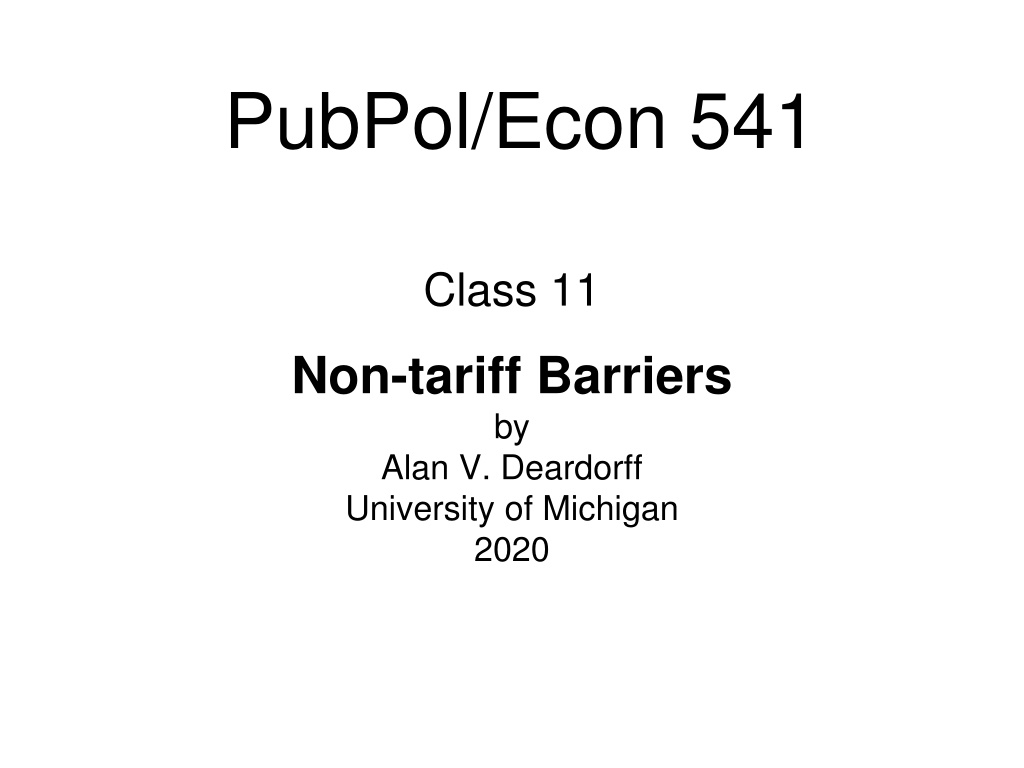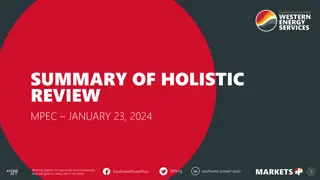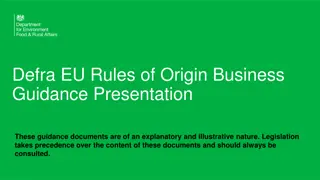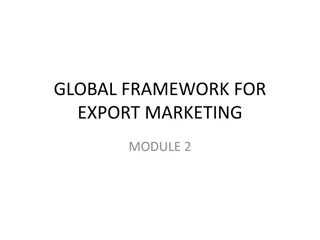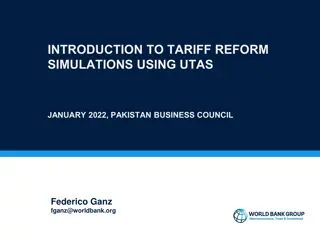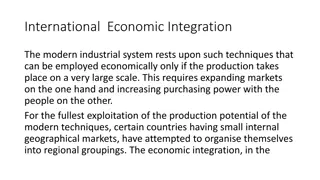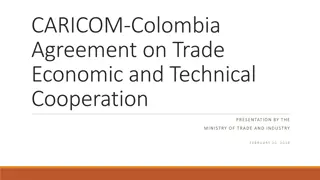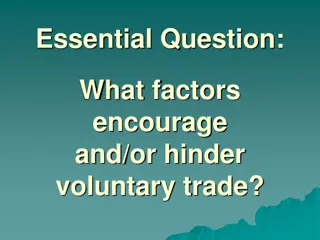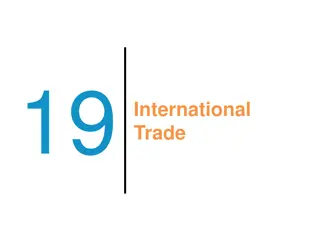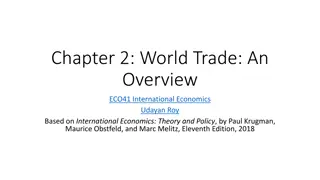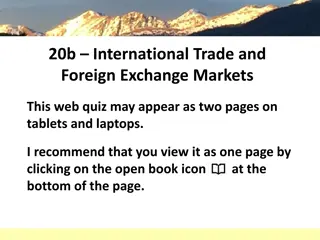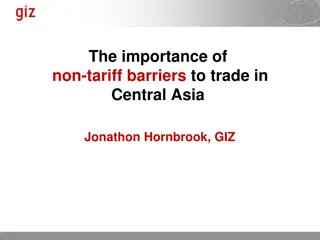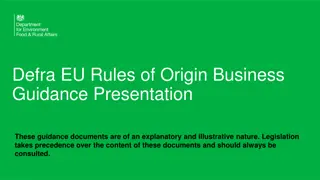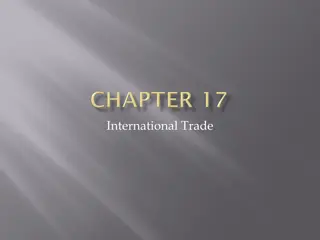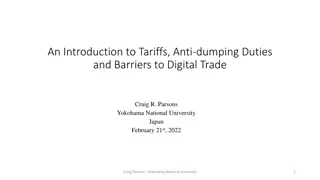Understanding Non-Tariff Barriers in International Trade
Explore the types of Non-Tariff Barriers (NTBs) and Non-Tariff Measures (NTMs) such as quotas, Tariff-Rate Quotas (TRQs), Voluntary Export Restraints (VERs), and more. Learn about Administered Protection, Safeguards tariffs, Anti-dumping duties, Countervailing duties, and their implications on trade. Dive into discussions on GATT/WTO regulations, welfare effects of VERs compared to tariffs, and the impact of local content requirements on input prices in international trade.
Download Presentation

Please find below an Image/Link to download the presentation.
The content on the website is provided AS IS for your information and personal use only. It may not be sold, licensed, or shared on other websites without obtaining consent from the author. Download presentation by click this link. If you encounter any issues during the download, it is possible that the publisher has removed the file from their server.
E N D
Presentation Transcript
PubPol/Econ 541 Class 11 Non-tariff Barriers by Alan V. Deardorff University of Michigan 2020
Outline Types of NTBs and NTMs Quota Analysis Perfect Competition Small country Large country Monopoly TRQs Other NTBs Empirics (Feenstra) Class 11: Non-tariff Barriers 2
NTBs Types of NTBs (Non-tariff barriers) Or NTMs (Non-tariff measures) Quotas TRQs (Tariff-Rate Quotas) VERs (Voluntary Export Restraints) Variable Levy Procurement Requirements Subsidies Local Content Requirements Export Credits Red Tape Standards Customs Valuation Procedures Tax Treatments Class 11: Non-tariff Barriers 3
NTBs Also: Administered Protection Defined as use of tariffs under procedures that may also have damping effect on trade Safeguards tariffs (aka Escape Clause in US) Levied against injurious imports Anti-dumping duties Levied against dumped imports CVDs (Countervailing duties) Levied against subsidized imports US Section 232 Levied against imports threatening national security Class 11: Non-tariff Barriers 4
Pause for Discussion Class 11: Non-tariff Barriers 5
Questions Countries are not allowed under the GATT/WTO to use quotas. How do they get away with it? Why is the EU s variable levy legal under the GATT/WTO? And why does Jackson nonetheless object to it? How do the welfare effects of a VER compare to those of a tariff? Why does a local content requirement raise the price of inputs to producers? Class 11: Non-tariff Barriers 6
Outline Types of NTBs and NTMs Quota Analysis Perfect Competition Small country Large country Monopoly TRQs Other NTBs Empirics (Feenstra) Class 11: Non-tariff Barriers 7
Quota analysis: Small country Assumptions throughout (Same as tariff) Markets perfectly competitive (but later monopoly) Product homogeneous Markets in equilibrium There are no distortions (externalities, etc.) Supply and demand curves linear Just for simplicity Model is partial equilibrium Model is static Free and frictionless trade Class 11: Non-tariff Barriers 8
Small country Special assumption for small country case World price is given (country too small to influence it) More correctly: country s supply and demand in that industry too small to influence the world price Class 11: Non-tariff Barriers 9
Quota under Perfect Competition Small country Quota sets a maximum quantity of imports, not price Price must adjust to whatever level reduces excess demand to the permitted quantity If excess demand (i.e., desired imports) is already less than the quota, then quota has no effect. It is not binding. (That won t be true with imperfect competition, as we ll see) Class 11: Non-tariff Barriers 10
Small country quota Effects of a binding quota, starting from free trade Price rises (by teq= tariff equivalent of quota ) Quantity supplied rises Quantity demanded falls Quantity of imports falls (to MQ) Tariff revenue? No Instead there is is quota rent teq MQ P S Paut P1=PW teq Rent P0=PW MQ=M1 D S0 D0 Q S1 D1 M0 Import Quota MQ Class 11: Non-tariff Barriers 11
Perfect Competition Small country Who gets the quota rent? Depends on how the rights to import under the quota are allocated First-come, first-served Whoever wins the race to the border Import licenses sold by home government Government revenue, just like tariff Import licenses granted to domestic people or firms They get the rents, which stay in the country Import licenses granted to foreign people, firms, or government Foreigners get the rents Class 11: Non-tariff Barriers 12
Small country quota, Rents domestic Welfare effects of a quota, starting from free trade with quota rights domestic Suppliers gain +a Demanders Lose (a+b+c+d) Rents +c Country loses (b+d) P S Paut P1=PW+t a c teq b d P0=PW D MQ=M1 (Same as tariff) S0 D0 Q S1 D1 Import Quota MQ Class 11: Non-tariff Barriers M0 13
Small country quota, Rents foreign Welfare effects of a quota, starting from free trade with quota rights foreign Home: Suppliers gain +a Demanders Lose (a+b+c+d) Country loses (b+c+d) Foreign: Rents +c World: S1 D1 Import Quota MQ (Worse than tariff for Home) P S Paut P1=PW+t teq a c b d P0=PW D MQ=M1 (b+d) S0 D0 Q M0 (Still Dead-weight loss for world) Class 11: Non-tariff Barriers 14
Pause for Discussion Class 11: Non-tariff Barriers 15
Questions (not asked before) If you were a producer, would you prefer being protected with a tariff or a quota? If you were a consumer, which would you prefer? Why do government tend to give quota rights to foreigners? In what ways, aside from the rents, do tariffs and quotas differ? Class 11: Non-tariff Barriers 16
Outline Types of NTBs and NTMs Quota Analysis Perfect Competition Small country Large country Monopoly TRQs Other NTBs Empirics (Feenstra) Class 11: Non-tariff Barriers 17
Large country quota, Rents foreign Welfare effects of a large- country quota with rents allocated to foreign Home: Private sector (S&D) loses (a+b) Country must lose (a+b) Foreign Private sector (S&D) loses (c+d) Quota rents +(a+c) Country may gain or lose: +a d World loses (b+d) World Market Home is Importer Foreign (*) is Exporter P XS* P1 teq a b d c P*1 MD MQ M1=X*1 M0=X*0 M,X* Now area a is a transfer from home to foreign, reflecting an improved terms of trade for foreign. Class 11: Non-tariff Barriers 18
Pause for Discussion Class 11: Non-tariff Barriers 19
Questions (not asked before) Why does large-country quota with rents to foreigners improve the foreign terms of trade? Class 11: Non-tariff Barriers 20
Outline Types of NTBs and NTMs Quota Analysis Perfect Competition Small country Large country Monopoly TRQs Other NTBs Empirics (Feenstra) Class 11: Non-tariff Barriers 21
Monopoly, Small Country Assumptions Product homogeneous World price is given (country too small to influence it) Home market has only a single producer Firm has increasing marginal cost Without trade, firm is a monopoly With free trade firm has no market power, as it takes world price as given Class 11: Non-tariff Barriers 22
Monopoly, Small Country We ll skip the analysis unless you are interested For more, see Skipped slides KOM Appendix to Chapter 9 We ll go straight the the results Class 11: Non-tariff Barriers 23
Monopoly in a closed economy P Recall Monopolist cares about marginal revenue Selects quantity QM where MR=MC Then charges the price PM at which this quantity is demanded MC PM D MR QM Q Class 11: Non-tariff Barriers 24
Monopoly in Free Trade P The firm can t charge above PW It produces QF where MC = PW Since DF>QF, the country imports (Had PW been enough higher, the firm and country would export.) MC PM PW D MR QF QM DF Q MF Class 11: Non-tariff Barriers 25
Monopoly with Tariff P Now the firm can charge up to PW +t, and it will, as long as PW +t < PM It produces QT where MC = PW +t If DT>QT, the country imports MT (If t were higher, imports would be zero and we re back to monopoly.) MC PM PW+t PW D MR QF QM QT DT DF Q MT Class 11: Non-tariff Barriers 26
Monopoly with Quota A quota MQ means that for prices above PW, demand faced by the monopolist is reduced (shifted left) by MQ. To D And marginal revenue becomes MR P D MR PW D MQ Q Class 11: Non-tariff Barriers 27
Monopoly with Quota: MQ = MT P Now the firm can charge a higher price, and it will It produces QQ where MC = MR and charges price PQ. Result: Imports are the same as under the tariff, but price is higher and quantity lower. The quota has given back to the firm some monopoly power. Class 11: Non-tariff Barriers MC PM PQ MR PT=PW+t PW D QF QM QQ QT DT DF Q MT 28
Non-binding Quota under Monopoly Here free trade imports are MF Set quota QM > MF Demand becomes DQ Equals D for P < PW Equals D QM for P > PW Marginal revenue is MRQ Output (at MRQ=MC) is QQ Price is PQ > PW Result: Non-binding quota can raise price under imperfect competition. P D DQ PQ MC QM PW MF MRQ QF QQ DF Q Class 11: Non-tariff Barriers 29
Monopoly, Small Country Results With perfect competition Quota set equal to imports under tariff raises price by same as tariff With monopoly Quota set equal to imports under tariff raises price by more than the tariff would have Even a quota set to more than free-trade imports (what would be expected to be a non-binding quota), may raise price. Class 11: Non-tariff Barriers 30
Pause for Discussion Class 11: Non-tariff Barriers 31
Questions (not asked before) Why does a large country using a quota (with rents given to foreigners) not benefit from an improvement in its terms of trade? Why does a monopolist benefit more from a quota than a tariff, if the quantity of imports is the same? How can a non-binding quota raise price? Class 11: Non-tariff Barriers 32
Outline Types of NTBs and NTMs Quota Analysis Perfect Competition Small country Large country Monopoly TRQs Other NTBs Empirics (Feenstra) Class 11: Non-tariff Barriers 33
Tariff-Rate Quotas (TRQs) Definition Low (or zero) tariff on imports below set quantity, Mtrq High(er) tariff on imports above Mtrq Class 11: Non-tariff Barriers 34
Tariff-Rate Quotas (TRQs) Effect is like a low tariff, a quota, or a high tariff, depending on levels of supply and demand Tariff Imports Mtrq Class 11: Non-tariff Barriers 35
Tariff-Rate Quotas (TRQs) Used by US for years on some agricultural products Trump on Korean steel US to settle other trade disagreements See Beattie Class 11: Non-tariff Barriers 36
Pause for Discussion Class 11: Non-tariff Barriers 37
Questions on Beattie, Mind your TRQs Why are TRQs inefficient and harmful? Who benefits most from a TRQ, and why? What was tariffication? When was it done? How was China hurt by TRQs in a case they took to the WTO in 2015? Class 11: Non-tariff Barriers 38
Outline Types of NTBs and NTMs Quota Analysis Perfect Competition Small country Large country Monopoly TRQs Other NTBs Empirics (Feenstra) Class 11: Non-tariff Barriers 39
NTBs Types of NTBs (Non-tariff barriers) Or NTMs (Non-tariff measures) Quotas TRQs (Tariff-Rate Quotas) VERs (Voluntary Export Restraints) Variable Levy Procurement Requirements Subsidies Local Content Requirements Export Credits Red Tape Standards Customs Valuation Procedures Tax Treatments Class 11: Non-tariff Barriers 40
Other NTBs: VERs World Market Home is Importer Foreign (*) is Exporter Voluntary Export Restraint has exporter limiting exports at request of importing country Effect is just like a quota with rents given to foreigners Rents go to foreigners Foreign country may gain P XS*VER XS* PVER PW MD M0=X*0 M,X* Class 11: Non-tariff Barriers 41
Other NTBs: Variable Levy World Market Home is Importer Foreign (*) is Exporter Importer uses a tariff (levy) but changes it to maintain a target domestic price, PV Notice how the size of the levy will change as Demand shifts right or left Supply shifts right or left Welfare effects are all exactly like a simple tarif. P XS* PV levy MD M0=X*0 M,X* Class 11: Non-tariff Barriers 42
Other NTBs: Procurement Requirements World Market Home is Importer Foreign (*) is Exporter Government limits its own purchases of import If government buys less than home production, then no effect, as private buyers just import more If government buys all home production, then Home price rises (to government) Foreign price falls (to private importers) Home buyers and sellers both gain but government loses more. P XS* PW P W MD MD M0=X*0 M,X* Class 11: Non-tariff Barriers 43
Other NTMs: Export Subsidy World Market Home is Exporter Foreign (*) is Importer (We ll see more detail in last class, Dec 8) Export subsidy gives $s to for each unit exported, so exporters get a higher price than foreign buyers pay Like large-country tariff, it Raises home price Helps suppliers Hurts demanders Unlike large-country tariff, it Costs the government Cannot benefit country (That last may change with imperfect competition.)Class 11: Non-tariff Barriers P XS P D PW P W s MD* MD M0=X*0 M,X* 44
Pause for Discussion Class 11: Non-tariff Barriers 45
Questions Suppose we are a small country and that foreign producers of imports to our country become more efficient, so that their costs fall. How will the effects of this change on the price and quantity of imports differ depending on whether we restrict imports with A tariff A quota A VER A variable levy A government procurement regulation If the import demand curve shifts to the right, how will a variable levy, a tariff, and a quota respond differently? Class 11: Non-tariff Barriers 46
Questions on Export Subsidy Why is a tariff needed to accompany an export subsidy? Why does an export subsidy raise the price of the good inside the exporting country? Can an export subsidy benefit the country that uses it (in the perfectly competitive model of the text)? Why or why not? Class 11: Non-tariff Barriers 47
Outline Types of NTBs and NTMs Quota Analysis Perfect Competition Small country Large country Monopoly TRQs Other NTBs Empirics (Feenstra) Class 11: Non-tariff Barriers 48
The Size of These Effects See Feenstra Uses analysis like this one to measure effects of protection Sectors with high US protection in 1985: Automobiles Dairy Steel Sugar Textiles and Apparel (All these had quotas and other NTBs as well as tariffs.) Class 11: Non-tariff Barriers 49
The Size of These Effects See Feenstra For 1985, U.S. average tariffs caused dead- weight loss (DWL) for U.S. of DWL = $1.2-3.4 billion per year Sounds like a lot! But U.S. 1985 GDP was $4,181 b. So DWL = 0.03% of GDP TINY! Class 11: Non-tariff Barriers 50
